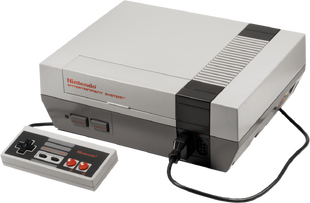
|
There are 169 stubs for enemies. Help out by expanding these pages! Item pages are now going to be split. See WikiBound:Projects for more information. |
|---|
Nintendo Entertainment System
| ファミリーコンピュータ Famirī Konpyūta | |
 North American model | |
| Release dates | |
| Japan | July 15, 1983 |
|---|---|
| North America | October 18, 1985 |
| Europe | September 1, 1986 |
| Technical information | |
| Display | 8-bit |
| Media | ROM cartridge |
| Other information | |
| Console generation | Third generation |
| Console type | Home console |
| Successor | Super Nintendo Entertainment System |
The Nintendo Entertainment System (Japanese: ファミリーコンピュータ Family Computer, or ファミコン Famicom), often abbreviated as the NES, is the second home video game console developed by Nintendo (the first being the Japan-only Color TV-Game series released from 1977-1980). This console is often credited with beginning the third generation of video and computer games. The first title in the EarthBound series was released for this system, though only in Japan. Sales for the Nintendo Entertainment System were high, with a strong lineup of exclusive games such as Kirby's Adventure, Metroid, and Ice Climbers. The console's best-selling titles are Super Mario Bros. and Super Mario Bros. 3. The Nintendo Entertainment System was succeeded by the Super Nintendo Entertainment System.
Many games for the Nintendo Entertainment System were re-released as Virtual Console titles on the Wii Shop Channel, the Nintendo eShop for the Nintendo 3DS and Wii U, and Nintendo Switch Online. Among these titles is Mother, which was released on the Wii U Virtual Console in 2015 and on Nintendo Switch Online in 2022. Several Nintendo Entertainment System titles are included in Super Smash Bros. Brawl and Super Smash Bros. for Wii U as Masterpieces.
EarthBound games for the Nintendo Entertainment System
Gallery
Trivia
- Ninten's name is an abbreviation of Nintendo and a nod to the Nintendo Entertainment System, much like how Ness's name is a reference to the Nintendo Entertainment System or the Super Nintendo Entertainment System.
| Systems with EarthBound and Super Smash Bros. games. |
|---|
| Home consoles NES • SNES • N64 • GCN • Wii • Wii U • Nintendo Switch Handheld consoles GBA • DS • 3DS • Nintendo Switch |
